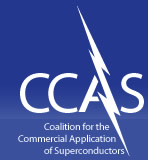Commercial Applications
- Properties, History and Challenges
- Overview
- Electric Power
- Transportation
- Medical Imaging and Diagnostics
- NMR for Medical and Materials Applications
- Industrial Processing
- High Energy Physics
- Wireless Communications
- Instrumentation, Sensors, Standards and Radar
- Large-Scale Computing
- Renewable Energy
- Cryogenics: An Enabling Technology
NMR for Medical and Materials Applications
NMR (Nuclear Magnetic Resonance) is a critical tool for genomics, drug discovery, biotechnology and materials science. Low Temperature Superconductor (LTS) materials enable the stable and homogeneous magnets required for precision NMR spectroscopy. Continued advances in superconducting materials have been repeatedly used to advance the performance of NMR systems, and thus benefit a wide range of science and technology applications.
A Versatile Enabling Tool
 [1]NMR is considered the most versatile spectroscopic tool in science today. In a 2003 report to the National Academies of Science, Robert Tycko
of NIH stated that “NMR is one of the most important techniques in modern science, with
applications in physics, chemistry, materials science, biology and medicine.” The discovery of NMR as an analytical technique and further refinements earned the 1952 Nobel Prize in Physics as well as the 1991 and 2002 Nobel prizes in Chemistry. The methods of Magnetic Resonance Imaging, which are based on NMR, earned the 2003 Nobel Prize in Medicine.
[1]NMR is considered the most versatile spectroscopic tool in science today. In a 2003 report to the National Academies of Science, Robert Tycko
of NIH stated that “NMR is one of the most important techniques in modern science, with
applications in physics, chemistry, materials science, biology and medicine.” The discovery of NMR as an analytical technique and further refinements earned the 1952 Nobel Prize in Physics as well as the 1991 and 2002 Nobel prizes in Chemistry. The methods of Magnetic Resonance Imaging, which are based on NMR, earned the 2003 Nobel Prize in Medicine.
NMR techniques have provided a fundamental tool for the study of materials in chemistry and physics laboratories for more than 40 years. Using modern methods of NMR spectroscopy, an incredible range of science and technology is addressed on a daily basis.
Some examples in materials science include the study of the chemistry of the fungal degradation of wood (a crucial recycling element in the global carbon cycle), the determination of the chemical structure of extraterrestrial matter in meteorites and the effects of various trace element additions on melt chemistry and matter flow in a variety of materials. In the life sciences, new methods use NMR as a diagnostic tool to identify people at greatest risk for developing heart disease by analyzing the size and concentration of lipoproteins, the small spheres that carry cholesterol around the body and deposit it in various locations. More importantly, by evaluating specific medications using NMR technology, physicians are better able to select cholesterol medications that will have optimal results for a patient depending on his or her lipoprotein size and concentration.
Proteomics and Drug Discovery
Proteins serve vital functions for sustaining life - from absorbing the oxygen we breathe, to digesting the food we eat, to producing the electrochemical signals that enable us to think. The structure and function of proteins remain at the frontier of life science. A typical protein is a chain of hundreds of amino acids combined in any of tens of thousands of patterns. While scientists have long been able to determine the sequences of many protein chains, the challenge is in the way this chain folds into a unique structure. It is this structure that determines the protein’s biochemical functions and properties; determining the structure is key to understanding the way it works. Knowing these structures has allowed drug companies to revolutionize drug-making processes, enabling them to develop drugs that specifically target certain proteins. In fact, finding the structure of a protein is such an achievement that many Nobel prizes have been given to those who have solved them. NMR has provided a powerful tool for protein structure determination and drug discovery.
Superconductivity: The Enabling Factor
The heart of the NMR spectrometer is a superconducting magnet. High field values and high homogeneity and stability of the magnetic field are essential to achieve the resolution and precision required for protein structure determination and other NMR analysis. With each advance made over the past 25 years in superconducting materials, first with niobium-titanium, then with niobium-tin conductors and now with a variety of materials suitable for ultra-high field applications, ever-higher field NMR spectrometers have been built and used to analyze increasingly complex molecules.
The Future of NMR
A recent report from the National Academies of Science on future opportunities in high magnetic field science states that present limitations on widely available superconducting materials will limit future NMR machines to the 1000 MHz (1 GHz) level. This report further recommends expanded development efforts aimed at higher field superconductors to enable further advances in NMR and other applications of high fields and points out enormous potential benefits of continued support for R&D in superconducting materials/magnets.
- [1] A 1000 MHz NMR spectrometer. Image courtesy of Bruker.

